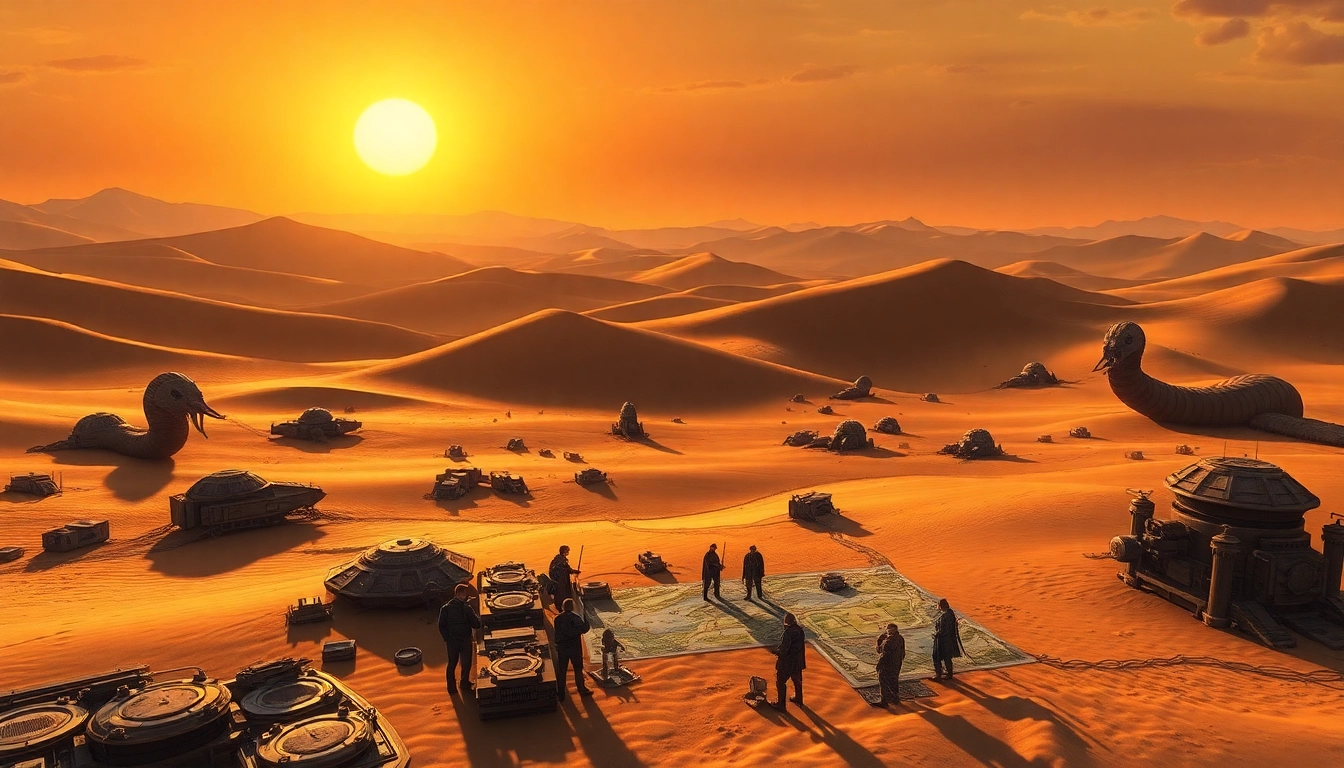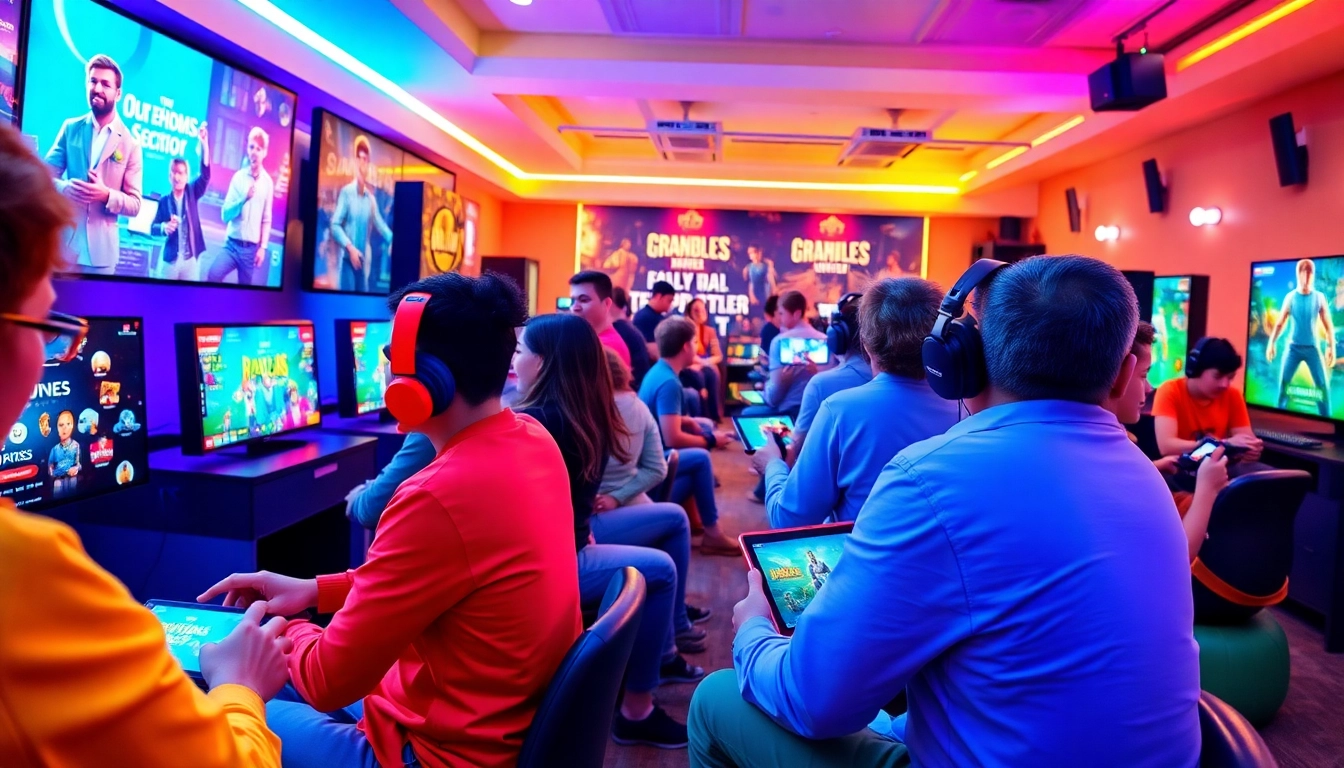Introduction to the Dune 2 Game
As one of the pioneering titles in the real-time strategy (RTS) genre, the dune 2 game has captivated players since its release in 1992. Developed by Westwood Studios and published by Virgin Interactive Entertainment, this game creatively merged compelling gameplay with the rich lore of Frank Herbert’s Dune universe. By establishing core mechanics and gameplay strategies that would resonate through the decades, Dune 2 became a landmark title, laying the groundwork for countless successors in the strategy gaming genre.
Overview of Dune 2 Game Development
The inception of Dune 2 can be traced back to the collaborative efforts of designers Brett Sperry, Aaron E. Powell, and Joseph Bostic at Westwood Studios. While creating this sequel, they were influenced by their earlier work on the original Dune video game, which faced various limitations that they aimed to surpass. Their goal was to construct an innovative game that would allow players to engage in competitive warfare, resource management, and strategic planning—all while immersing them in the universe based on Herbert’s beloved series.
When Dune 2 was launched, it introduced gamers to a new perspective of gameplay through its isometric viewpoint and intuitive controls, which significantly simplified the experience compared to other contemporary strategy games. Players could choose from three unique factions: the noble House Atreides, the nefarious House Harkonnen, or the enigmatic House Ordos. Each house comes with distinctive strengths, weaknesses, and objectives, adding layers of depth to strategic planning.
Historical Context: Video Game Evolution in 1992
The early 1990s marked a turning point in the gaming industry, with the rise of more complex and engaging game designs that moved away from traditional linear experiences. Released in an era dominated by side-scrolling games and 2D platformers, Dune 2 emerged as a fresh alternative in the genre. It was effectively a forerunner to many real-time strategy games that would come to define the industry.
Throughout 1992, various advancements in computer technology, including better graphics capabilities and improved sound hardware, allowed for more intricate game designs. Dune 2 capitalized on these advancements, offering an experience that not only showcased its strategic depth but also its impressive visuals and audio design, which were unparalleled for the time.
Impact of Dune 2 Game on the RTS Genre
Dune 2 set the standard for future real-time strategy games and has been credited with establishing several conventions that are still in use today. Key innovations included the concept of base building, the resource gathering system tied to the elusive spice (the game’s main commodity), and the intuitive interface that simplified many actions for players.
The game’s design principles would eventually influence celebrated franchises such as Command & Conquer, StarCraft, and Age of Empires. Each of these games built upon the foundation that Dune 2 laid, incorporating features that enhanced player engagement and strategic complexity. Given its monumental role in shaping the genre, many regard Dune 2 as not just an influential game, but a historical cornerstone in the evolution of video gaming itself.
Gameplay Mechanics of the Dune 2 Game
At its core, the gameplay of Dune 2 emphasizes strategic decision-making, resource management, and tactical unit deployment. Players find themselves immersed in the harsh desert landscapes of Arrakis, where they must navigate complex conditions to achieve their objectives.
Core Strategy Elements in Dune 2 Game
The primary objective in Dune 2 revolves around controlling and harvesting spice, which players use to fund military expansion and technological advancements. The game thrusts players into a strategic conflict where they must scout for spice fields, establish bases, and create an army capable of dominating rival factions.
Each game session begins with a construction phase where players build essential structures like barracks, factories, and power plants. The time management aspect comes into play as players must balance between expanding their facilities and managing their resources efficiently. This intricate blend of strategy comes together to create a challenging experience, requiring foresight and planning.
Unit Types and Resources Management
Dune 2 is populated with a diverse array of units, each with unique attributes and functionalities. Players can command infantry, vehicles, and advanced technologies, each serving distinct tactical roles in the battlefield. For instance, harvesting units are crucial for gathering spice, while combat units protect these resources from enemy raids.
Resource management is pivotal in Dune 2; players must oversee the production of units while keeping their economy afloat. The essence of success in this game lies in strategic planning—determining when to expand territory, invest in military advancements, or reinforce defenses becomes crucial as the game progresses.
Comparative Analysis with Modern RTS Games
While many modern RTS games have adopted advanced graphics and more intricate mechanics, the foundational elements established in Dune 2 remain relevant. Modern titles often integrate elements of storytelling, real-time decision-making, and balancing gameplay, which can be traced back to Dune 2’s design.
The resource management system seen in today’s RTS games often aligns with what was pioneered by Dune 2. The divide between combat units and economic units, as well as the necessity to gather resources for unit production, serves as a template that many developers have adapted in their titles. Furthermore, the innovative user-interface and control mechanics of Dune 2 have informed a great deal of the user experiences offered by contemporary games in the genre.
Visuals and Sounds of the Dune 2 Game
In addition to its strategic gameplay, Dune 2’s artistic and auditory elements significantly contributed to its appeal. The game’s ability to create an immersive experience can be attributed to its visual design and soundtrack, crafted with great care to reflect the essence of the Dune universe.
Artistic Design Inspired by the Dune Universe
The artistic design of Dune 2 cleverly incorporates elements from Herbert’s Dune universe, drawing inspiration from the series’ iconic imagery. The stark deserts of Arrakis, the sandy palettes, and the intricate designs of various units and structures all come alive through pixel art, showcasing the creativity of the developers in an era when 8-bit graphics were commonplace.
From the depiction of immense sandworms to the architectural styles of the factions, every visual aspect has been crafted to authentically represent the Dune saga. As players traverse different terrains and engage in battles, the vibration of sandstorms and other environmental effects enhances the overall aesthetics, enriching the gaming experience.
Soundtrack Elements by Frank Klepacki
The musical score for Dune 2, composed by Frank Klepacki, is celebrated for its memorable and atmospheric soundtracks, serving to enhance the intensity of gameplay. Each thematic piece aligns with the different factions, emphasizing their distinct characteristics and cultures.
Klepacki’s compositions stand out for their ability to evoke the feeling of the Dune universe, capturing the imagination of players through a blend of electronic sounds and orchestral arrangements. As players build their empires or wage wars, the continuously evolving score responds to the action, adding depth and excitement to the gameplay.
Technical Specifications and Platforms
Dune 2 was initially released on various platforms, most notably the DOS, Amiga, and Sega Genesis, showcasing its accessibility at the time. The technical specifications of these systems defined the limitations of the game, yet the developers maximized the potential of available hardware to deliver an engaging experience.
By implementing pixel art, modest sound design, and simple yet effective gameplay mechanics, Dune 2 could be enjoyed on different systems without sacrificing its core features. As technology evolved, Dune 2 inspired remakes and adaptations that aimed to bring its classic gameplay to modern audiences.
Community and Legacy of the Dune 2 Game
The cultural impact of Dune 2 extends beyond its initial release. The title has managed to create a dedicated community, ensuring its legacy persists through fan engagement and nostalgic appreciation. Over the years, players have revisited Dune 2 through retro gaming collections and remakes, celebrating its contribution to the RTS genre.
Fan Base and Community Contributions
Since its launch, Dune 2 has garnered a loyal following among strategy enthusiasts. Online forums and communities dedicated to strategizing gameplay strategies and sharing fan-created content have kept the spirit of the game alive. These platforms often serve as a repository for discussions about gameplay mechanics, modding experiences, and competitive play, engaging both new and veteran players.
Community contributions extend to mods and fan projects, allowing players to creatively expand on the game. Such endeavors not only showcase the talent within the community but also illustrate how collective passion can reinvigorate interest in a classic title.
Retrospective Reviews and Historical Perspectives
As time has passed since the release of Dune 2, retrospective evaluations highlight its influence on the gaming landscape. Critics and gamers alike acknowledge its importance in rising the popularity of RTS games and pioneering many conventions now taken for granted.
Recordings of gameplay sessions, critical reviews across gaming mediums, and discussions on its impact have surfaced, contributing to a greater understanding of its place in video game history. The discussions reflect a common sentiment of admiration for Dune 2, emphasizing its role as a precursor to the modern strategy games enthusiasts enjoy today.
The Dune 2 Game’s Influence on Future Titles
The influence of Dune 2 extends far beyond its own franchise; it has served as a template for numerous other strategy games released in subsequent years. Titles that embraced the balance of resource management, unit control, and competitive gameplay can trace their roots back to the innovative design established by Dune 2.
From its innovative systems to its engaging gameplay mechanics, Dune 2 helped bring the RTS genre into the mainstream, leading to an explosion of new titles that would continue to evolve and expand upon its foundational elements. The core ideas, concepts, and gameplay mechanics forged in Dune 2 continue to inspire developers and entertain players worldwide.
How to Play and Experience the Dune 2 Game Today
The allure of Dune 2 remains vibrant, and modern gamers are delighted to discover ways to experience this classic. Despite its age, the game has become increasingly accessible, allowing new audiences to immerse themselves in its strategic depth.
Accessing Dune 2 Game on Modern Systems
With prevalent retro gaming platforms and emulators, players can easily access and play Dune 2 on modern systems. Services that offer classic titles ensure that the game’s original mechanics and visuals are preserved while accommodating contemporary technology. Additionally, there are options for online versions that retain the classic gameplay while allowing for broader reach in the ever-growing gaming community.
Moreover, fan-made remakes have emerged, breathing new life into Dune 2 with enhanced graphics and gameplay features tailored for modern audiences. These projects reflect both respect for the original and a desire to innovate upon established foundations.
Tips and Tricks for New Players
For newcomers venturing into the world of Dune 2, understanding the core mechanics is paramount. Familiarizing oneself with resource management is critical, as efficient spice harvesting and allocation can often determine success. Here are a few tips:
- Scout Early: Expanding your knowledge of the map will help you locate spice fields and enemy bases early on.
- Prioritize Resource Collectors: Always ensure you have enough units dedicated to spice harvesting before focusing on combat forces.
- Balance Offense and Defense: Striking a balance between building combat units and reinforcing defensive structures will secure both offensive and defensive strategies.
- Plan for Unit Upgrades: Investing in unit upgrades allows for stronger and more versatile forces as you progress further into the game.
Engagement with Online Communities and Mods
As an integral part of the enduring appeal of Dune 2, engaging with online communities can provide new players with valuable insights and strategies. Forums, Reddit threads, and dedicated fan sites are filled with resources that can help both newcomers and veterans explore various aspects of gameplay.
Furthermore, discovering and experimenting with community-created mods can significantly enhance the gaming experience. Mods can introduce new content, gameplay mechanics, and visual enhancements that breathe new life into the classic title, ensuring that players remain engaged and entertained.



